 |
| Finance Minister Hong Nam-ki announces the government’s home supply plan at the government complex in Seoul on Aug. 4, 2020./ Photographed by Song Eui-joo (songuijoo@) |
AsiaToday reporter Lee Chul-hyun
There is growing concern that the government’s large-scale housing supply plan in Seoul and the greater capital region aimed at stabilizing the real estate market may run aground as it faces opposition from local governments and residents. The scale of home supply has been either greatly reduced or even canceled in key regions such as Gangnam, Yongsan, and Taereung in Seoul as well as Gwacheon in Gyeonggi Province. The conflict is expected to intensify as the government announced the plan without listening to the local governments and residents.
According to the Ministry of Land, Infrastructure and Transport, the government’s housing supply plan in the Seoul metropolitan area announced in August 2020 is being hindered by protests from residents and local governments in various places.
The government’s plan to supply 3,000 housing units on the site for former Seoul Medical Center in Samseong-dong is likely to be cut by nearly quarter. “The government’s home supply plan on the site of the Seoul Medical Center is unrealistic,” the Seoul metropolitan government said. “It is appropriate to supply 800 houses,” it said. The land ministry, which is in charge of the housing plan, seems to be baffled by the Seoul city’s sudden supply cut. A land ministry official expressed dissatisfaction saying, “Nothing has been discussed.”
The site for the Seoul Medical Center is not the only place where the government’s housing supply plan is being disrupted. In August 2020, the government had said it would supply nearly 4,000 housing units in a former government complex in Gwacheon. However, the plan was abolished in June last year as if faced strong opposition from the Gwacheon city and its residents. The government struggled to meet the supply by searching for an alternative site.
The number of units to be supplied on the Taereung CC site in Nowon-gu, Seoul, has been reduced to 6,800 from the original 10,000 units due to strong opposition from Nowon residents. Besides, the designation of the site initially scheduled for the first half of this year remains unclear due to deliberation by the Cultural Heritage Administration.
There are many other sites that are not making much progress due to opposition from local governments and residents, including the unsold site of Sangam DMC in Mapo-gu, and the site of the Western Driver’s License Examination Center.
The Yongsan Maintenance Depot site is also expected to take long time to provide more housing units. The government plans to supply 10,000 housing units on the Yongsan site, but the Seoul metropolitan government is reportedly preparing guidelines to reduce the supply of housing and focus on the expansion of business facilities.
Industry observers point out that this was already expected due to the government’s poor supply measures. The government’s unilateral push without any discussion with locals governments or residents brought backlash. There are a total of 8 major supply sites in Seoul that is planned to provide more than 1,000 housing units. Among them, only one site, which is the unsold site of the Seoul Housing and Urban Corporation (SH) in Magok, is progressing smoothly.
“The predicted opposition is becoming a reality as the government allocated regions and supplies unilaterally without discussion with local governments and residents in advance,” said Lee Eun-hyung, a senior researcher at construction policy institute RICON. “If local backlash spreads, the housing market in Seoul and the greater Seoul area, which have been stabilized, may become unstable again.”
#home supply plan #Seoul
Copyright by Asiatoday
Most Read
-
1
-
2
-
3
-
4
-
5
-
6
-
7





















